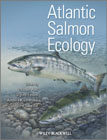
The Atlantic salmon is one of the most prized and exploited species worldwide, being at the centre of a massive sports fishing industry and increasingly asthe major farmed species in many countries worldwide. Atlantic Salmon Ecologyis a landmark publication, both scientifically important and visually attractive. Comprehensively covering all major aspects of the relationship of the Atlantic salmon with its environment, chapters include details of migration and dispersal, reproduction, habitat requirements, feeding, growth rates, competition, predation, parasitsm, population dynamics, effects of landscape use, hydropower development, climate change, and exploitation. The book closes with a summary and look at possible future research directions. Backed by the Norwegian Research Council and with editors and contributors widely known and respected, Atlantic Salmon Ecology is an essential purchase for all those working withthis species, including fisheries scientists and managers, fish biologists, ecologists, physiologists, environmental biologists and aquatic scientists, fish and wildlife department personnel and regulatory bodies. Libraries in all universities and research establishments where these subjects are studied and taught should have copies of this important publication. * Comprehensive and up-to-date coverage of Atlantic Salmon * Atlantic Salmon is one of the world's most commercially important species * Backed by the Norwegian Research Council *Experienced editor and internationally respected contributors INDICE: Foreword. Preface and acknowledgements. Reviewers. Contributors. Glossary. 1 Aquatic Nomads: The Life and Migrations of the Atlantic Salmon. EvaB. Thorstad, Fred Whoriskey, Audun H. Rikardsen from juvenile life in the river to feeding in the ocean. 1.4.1 Downriver smolt migration. 1.4.2 Marine post-smolt migration. 1.5 Spawning migration from feeding in the ocean to spawningin the river. 1.5.1 Returning from ocean feeding grounds and entering the rivers. 1.5.2 Upstream river migration. 1.5.3 Factors affecting the upstream river migration. 1.6 Kelt migration after spawning and during outward migration. 1.7 Homing and orientation mechanisms. 1.8 Conclusion and future research needs. References. 2 Reproductive Ecology: A Tale of Two Sexes. Ian A. Fleming The Russian doll killer. 9.3.2 The agent: pathogenic or benign? Taxonomic issues surrounding. G. salaris. 9.3.3 The physicochemical environment: The role of environment in shaping infection outcomes. 9.4 Managing disease in wild salmonid populations. References. 10 The Effect of Sea Lice on Atlantic Salmon and other Salmonid Species. Bengt Finstad, Pål A. BjOrn, Christopher D. Todd, Fred Whoriskey, Patrick G. Gargan, Gregory Forde adult returns. 10.3 The sea lice story from Canada. 10.3.1 Historical data. 10.3.2 Effects of sea lice on Atlantic salmon east coast. 10.3.3 Effects of sea lice on salmonids west coast. 10.4 The sea lice story from Ireland. 10.4.1 Effects of sea lice on Atlantic salmon. 10.4.2 Effects of sea lice on sea trout. 10.5 The sea lice story from Scotland. 10.5.1 Historical data. 10.5.2 Effects of sea lice on Atlantic salmon. 10.6 Management. 10.6.1 Sea lice management in Norway. 10.6.2 Sea lice management in Canada. 10.6.3 Sea lice management in Ireland. 10.6.4 Sea lice management inScotland. 10.7 Concluding remarks. References. 11 Variation in Population Size through Time and Space: Theory and Recent Empirical Advances from Atlantic Salmon. Sigurd Einum transfer from data-rich to data-poor rivers. 12.4.2 Spawning targets for North America. 12.4.3 Spawning targets for Europe. 12.4.4 Spawning target uncertainties. 12.5 Exploitation. 12.5.1 History of exploitation. 12.5.2 Exploitation rates. 12.5.3 Composition of catches. 12.6 Evolutionary andecological effects of fishing. 12.7 Management implications. References. 13 Landscape and Land Use Effects on Atlantic Salmon. Ola Ugedal Ecological Effects. BjOrn Ove Johnsen, Jo Vegar Arnekleiv, Lars Asplin, BjOrn T. Barlaup, Tor F. Næsje, BjOrn Olav Rosseland, Svein Jakob Saltveit & Arve Tvede 14.1 Introduction. 14.2 Changes in physical, chemical, hydrological and biologicalfactors in rivers and fjord systems as a consequence of hydropower development. 14.2.1 River systems. 14.2.2 Fjord systems. 14.3 Changes in survival, growth, migration and production of salmon in rivers and fjords. 14.3.1 Rivers. 14.3.2 Fjord systems. 14.4 Measures to compensate for negative effects of hydropower development. 14.4.1 Use of biological and physical measures. 14.5 Conclusion. References. 15 Lessons from Acidification and Pesticides. BjOrn Olav Rosseland & Frode Kroglund 15.1 General water quality of Atlantic salmon rivers. 15.2 Major classes of pollutants. 15.3 Acidification. 15.4 Pesticides and Atlantic salmon.15.5 Conclusion. References. 16 Getting into Hot Water? Atlantic Salmon Responses to Climate Change in Freshwater and Marine Environments. Christopher D. Todd, Kevin D. Friedland, Julian C. MacLean, Neil Hazon & Arne J. Jensen 16.1 Introduction. 16.2 Past and present climate for Atlantic salmon. 16.3 Upstream river migration and spawning. 16.4 Eggs and alevins. 16.5 Parr life. 16.6 Smolt migration. 16.7 Geographical distribution and recent trends in adult stock abundance. 16.8 Ocean climate influences on run-timing and adult abundance/recruitment. 16.9 Migration, diurnal behaviour and changes in the epipelagic food web. 16.10 Do changes in North Atlantic zooplankton communities comprise regime shifts?. 16.11 Change in size and growth in the marine environment. 16.12 Adult somatic condition and lipid reserves: indicators of ocean climate deterioration?. 16.13 Maturity schedules. 16.14 Large-scale indicator indices of oceanclimate change and impacts on salmon. 16.15 Management issues and responses to changes in ocean climate. References. 17 Salmon Ecological Research and Conservation. Oystein Aas, David Policansky, Sigurd Einum & Jostein Skurdal 17.1 Introduction. 17.2 Ecological research that contributes to conservation. 17.3 Environment, genetics, and changes in life-history. 17.4 Enhanced cooperation. 17.5 Multidisciplinary science. References. Index.
- ISBN: 978-1-4051-9769-4
- Editorial: Wiley-Blackwell
- Encuadernacion: Cartoné
- Páginas: 496
- Fecha Publicación: 01/10/2010
- Nº Volúmenes: 1
- Idioma: Inglés
